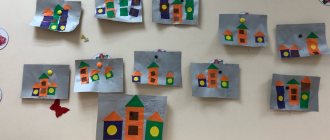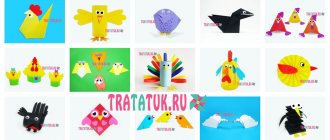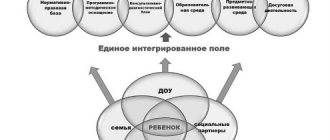DOMOSTROYPlumbing and construction
Albina Dilmukhametova
Summary of a lesson on designing three-dimensional “Mouse” toys from paper
Abstract
on designing three-dimensional toys from paper and
acquaintance with the outside world for children of the middle group on the topic:
Goal: Learn to make a three-dimensional figurine of a mouse out of paper.
Generalize, systematize, clarify ideas about geometric shapes and geometric bodies.
- learn to select projections for geometric bodies; promote awareness of the significant difference between geometric bodies and geometric figures, memorization of basic terminology (geometric bodies, geometric figures, projections).
- develop the ability to perceive objects and phenomena in their relationships; develop constructive knowledge aimed at imagination; develop the ability to analyze circuits and structures.
— To cultivate artistic taste, work culture, curiosity, mutual assistance, independence, interest and objectivity in the buildings of other children.
Paper is one of the simplest, most accessible, and easily processed materials. We become familiar with paper products from early childhood.
Depending on the design and purpose of the product, paper is used that differs in thickness, texture, texture and color. Colored paper, velvet, and cardboard are suitable for applique. For work related to storage, thin writing and colored paper is used. Cardboard, half-canton, thick paper are used for the manufacture of various structures.
There are different types of paper products: products made from strips, products using the appliqué technique, products based on boxes, cones, cylinders; production of various layouts...
Progress of the lesson
I want to show you the process of making a three-dimensional paper mouse based on cones, it is very simple, accessible, does not take much time, and at the same time, by understanding the basis, you can make other characters from rural life and more using this principle.
Firstly, to make a paper bunny craft we will need colored paper, scissors, a marker and PVA glue. We choose what color we will have a front sight and get to work. We draw the details of our mouse on a selected sheet of colored paper.
Secondly, we cut out parts for our craft from paper of any color: ears, paws, 2 semicircles, for cones. Glue the cone and a small truncated cone together. The truncated cone will be the head, and the long cone will become the base of our mouse.
Thirdly, we draw a muzzle and glue the ears to our mouse.
The final stage.
Fourthly, we glue our mouse. Making a three-dimensional paper mouse craft is complete.
Our mouse is ready!
Summary of an integrated lesson on familiarizing preschoolers with the outside world and designing from paper Municipal budgetary preschool educational institution "Kindergarten No. 23" Summary of an integrated lesson on familiarizing preschoolers.
Summary of a lesson on paper design in the preparatory group “Wintering Birds” Title of the work: “Wintering Birds” Author: Shavlova E. N. MADOU No. 85, Tyumen. Age of children: preparatory group (6-7 years old) Material:.
Summary of a lesson on designing paper using the origami technique “Butterfly” Goal: to develop interest in origami as an activity; develop the ability to perform a butterfly figure using the origami method according to the teacher’s instructions;
Summary of a lesson on designing from paper in the preparatory group “Garland of roses” “Garland of roses” Goal: creating voluminous rosebuds from paper. Objectives: Educational: 1) introduce the technology of making buds.
Summary of a lesson on designing from paper “Valentine “Mouse” from hearts” Summary of a lesson on designing from paper “Making a Valentine. Mouse made of hearts." Krutovskaya Natalya Summary of the design lesson.
Differences between design classes in the senior group
In older preschool age (5-6 years), pupils already know the basic methods of creating paper products. They must become familiar with three-dimensional figures (sphere, cube, cone, cylinder, pyramid, brick) and learn to place them in space, making durable structures.
The teacher teaches children to see familiar elements in product samples, to work not only according to the sample, but also according to the drawings. You can start building with cubes of different shapes and sizes, and then make figures out of paper.
At this time, the already mastered skills of replacing parts with others, connecting them, using different techniques for working with paper of different densities are consolidated. Teachers organize collective activities to create 1 item.
Sometimes classes are held in the form of a role-playing game. For example, an adult says that the hare needs help: his home was destroyed by a fox. Some children can become builders and make a house, another part can become guards and design a fence, a third can design furniture, etc.
The older the children, the more creativity there should be in their work. If with younger students you can limit yourself to creating crafts based on a model, in the middle group you can teach how to work with drawings and diagrams, then in the older group, preschoolers can come up with a product on their own on a given topic.





